Analysis of Leadership and Management at Rolls Royce Plc: A Report
VerifiedAdded on 2023/01/13
|11
|2705
|30
Report
AI Summary
This report provides a comprehensive analysis of leadership and management practices within Rolls Royce Plc. It begins by defining and comparing the diverse roles and characteristics of managers and leaders, highlighting their distinct responsibilities. The report then examines how these roles and functions are applied in various situational contexts, such as product launches and conflict management, providing real-world examples. Furthermore, it delves into the application of different leadership theories and models, including situational leadership, system leadership, and contingency leadership, illustrating how they are utilized to address specific challenges and achieve organizational goals. The report concludes by summarizing the key findings and insights regarding effective leadership and management strategies in the context of the automotive industry.
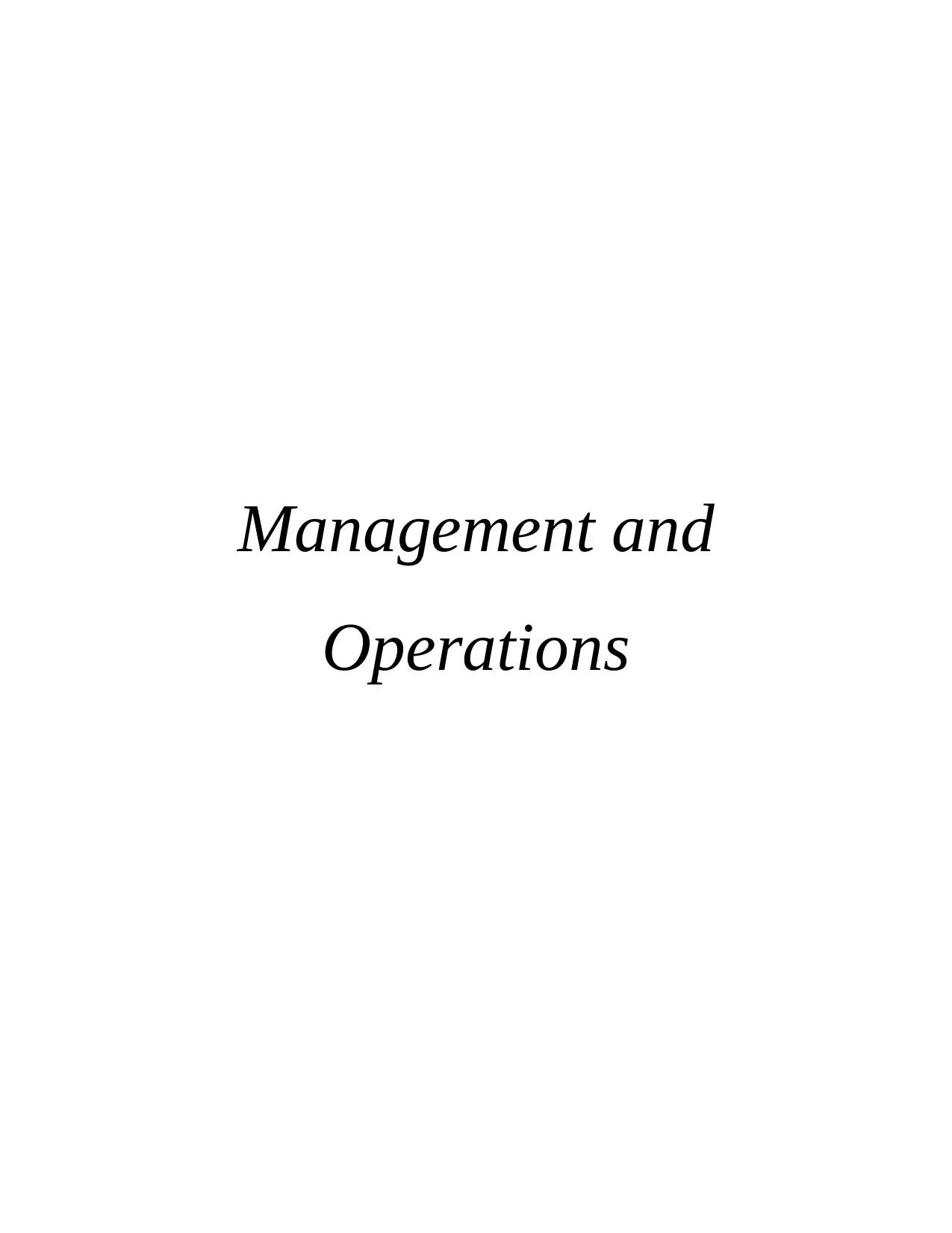
Management and
Operations
Operations
Paraphrase This Document
Need a fresh take? Get an instant paraphrase of this document with our AI Paraphraser
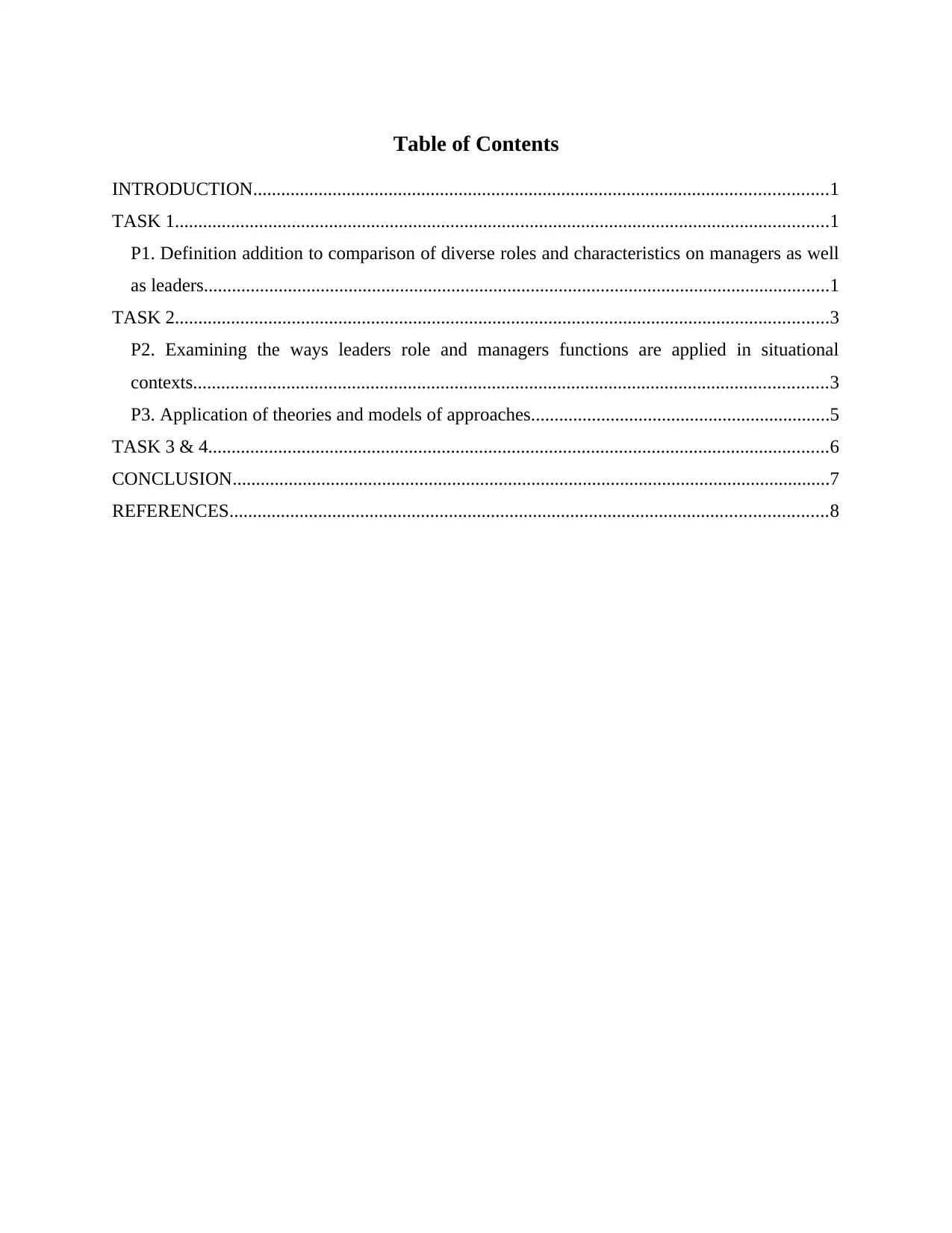
Table of Contents
INTRODUCTION...........................................................................................................................1
TASK 1............................................................................................................................................1
P1. Definition addition to comparison of diverse roles and characteristics on managers as well
as leaders......................................................................................................................................1
TASK 2............................................................................................................................................3
P2. Examining the ways leaders role and managers functions are applied in situational
contexts........................................................................................................................................3
P3. Application of theories and models of approaches................................................................5
TASK 3 & 4.....................................................................................................................................6
CONCLUSION................................................................................................................................7
REFERENCES................................................................................................................................8
INTRODUCTION...........................................................................................................................1
TASK 1............................................................................................................................................1
P1. Definition addition to comparison of diverse roles and characteristics on managers as well
as leaders......................................................................................................................................1
TASK 2............................................................................................................................................3
P2. Examining the ways leaders role and managers functions are applied in situational
contexts........................................................................................................................................3
P3. Application of theories and models of approaches................................................................5
TASK 3 & 4.....................................................................................................................................6
CONCLUSION................................................................................................................................7
REFERENCES................................................................................................................................8

⊘ This is a preview!⊘
Do you want full access?
Subscribe today to unlock all pages.

Trusted by 1+ million students worldwide
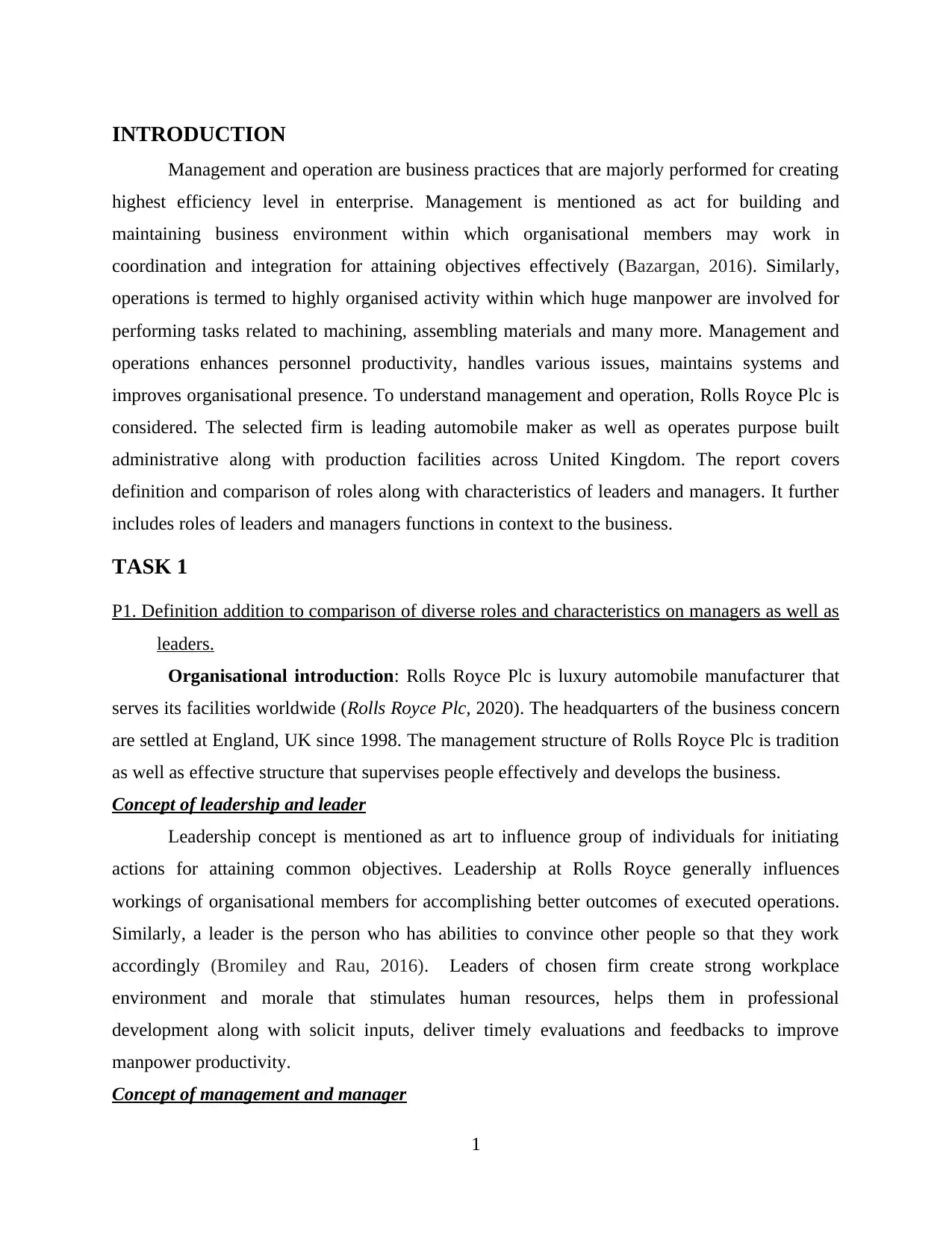
INTRODUCTION
Management and operation are business practices that are majorly performed for creating
highest efficiency level in enterprise. Management is mentioned as act for building and
maintaining business environment within which organisational members may work in
coordination and integration for attaining objectives effectively (Bazargan, 2016). Similarly,
operations is termed to highly organised activity within which huge manpower are involved for
performing tasks related to machining, assembling materials and many more. Management and
operations enhances personnel productivity, handles various issues, maintains systems and
improves organisational presence. To understand management and operation, Rolls Royce Plc is
considered. The selected firm is leading automobile maker as well as operates purpose built
administrative along with production facilities across United Kingdom. The report covers
definition and comparison of roles along with characteristics of leaders and managers. It further
includes roles of leaders and managers functions in context to the business.
TASK 1
P1. Definition addition to comparison of diverse roles and characteristics on managers as well as
leaders.
Organisational introduction: Rolls Royce Plc is luxury automobile manufacturer that
serves its facilities worldwide (Rolls Royce Plc, 2020). The headquarters of the business concern
are settled at England, UK since 1998. The management structure of Rolls Royce Plc is tradition
as well as effective structure that supervises people effectively and develops the business.
Concept of leadership and leader
Leadership concept is mentioned as art to influence group of individuals for initiating
actions for attaining common objectives. Leadership at Rolls Royce generally influences
workings of organisational members for accomplishing better outcomes of executed operations.
Similarly, a leader is the person who has abilities to convince other people so that they work
accordingly (Bromiley and Rau, 2016). Leaders of chosen firm create strong workplace
environment and morale that stimulates human resources, helps them in professional
development along with solicit inputs, deliver timely evaluations and feedbacks to improve
manpower productivity.
Concept of management and manager
1
Management and operation are business practices that are majorly performed for creating
highest efficiency level in enterprise. Management is mentioned as act for building and
maintaining business environment within which organisational members may work in
coordination and integration for attaining objectives effectively (Bazargan, 2016). Similarly,
operations is termed to highly organised activity within which huge manpower are involved for
performing tasks related to machining, assembling materials and many more. Management and
operations enhances personnel productivity, handles various issues, maintains systems and
improves organisational presence. To understand management and operation, Rolls Royce Plc is
considered. The selected firm is leading automobile maker as well as operates purpose built
administrative along with production facilities across United Kingdom. The report covers
definition and comparison of roles along with characteristics of leaders and managers. It further
includes roles of leaders and managers functions in context to the business.
TASK 1
P1. Definition addition to comparison of diverse roles and characteristics on managers as well as
leaders.
Organisational introduction: Rolls Royce Plc is luxury automobile manufacturer that
serves its facilities worldwide (Rolls Royce Plc, 2020). The headquarters of the business concern
are settled at England, UK since 1998. The management structure of Rolls Royce Plc is tradition
as well as effective structure that supervises people effectively and develops the business.
Concept of leadership and leader
Leadership concept is mentioned as art to influence group of individuals for initiating
actions for attaining common objectives. Leadership at Rolls Royce generally influences
workings of organisational members for accomplishing better outcomes of executed operations.
Similarly, a leader is the person who has abilities to convince other people so that they work
accordingly (Bromiley and Rau, 2016). Leaders of chosen firm create strong workplace
environment and morale that stimulates human resources, helps them in professional
development along with solicit inputs, deliver timely evaluations and feedbacks to improve
manpower productivity.
Concept of management and manager
1
Paraphrase This Document
Need a fresh take? Get an instant paraphrase of this document with our AI Paraphraser
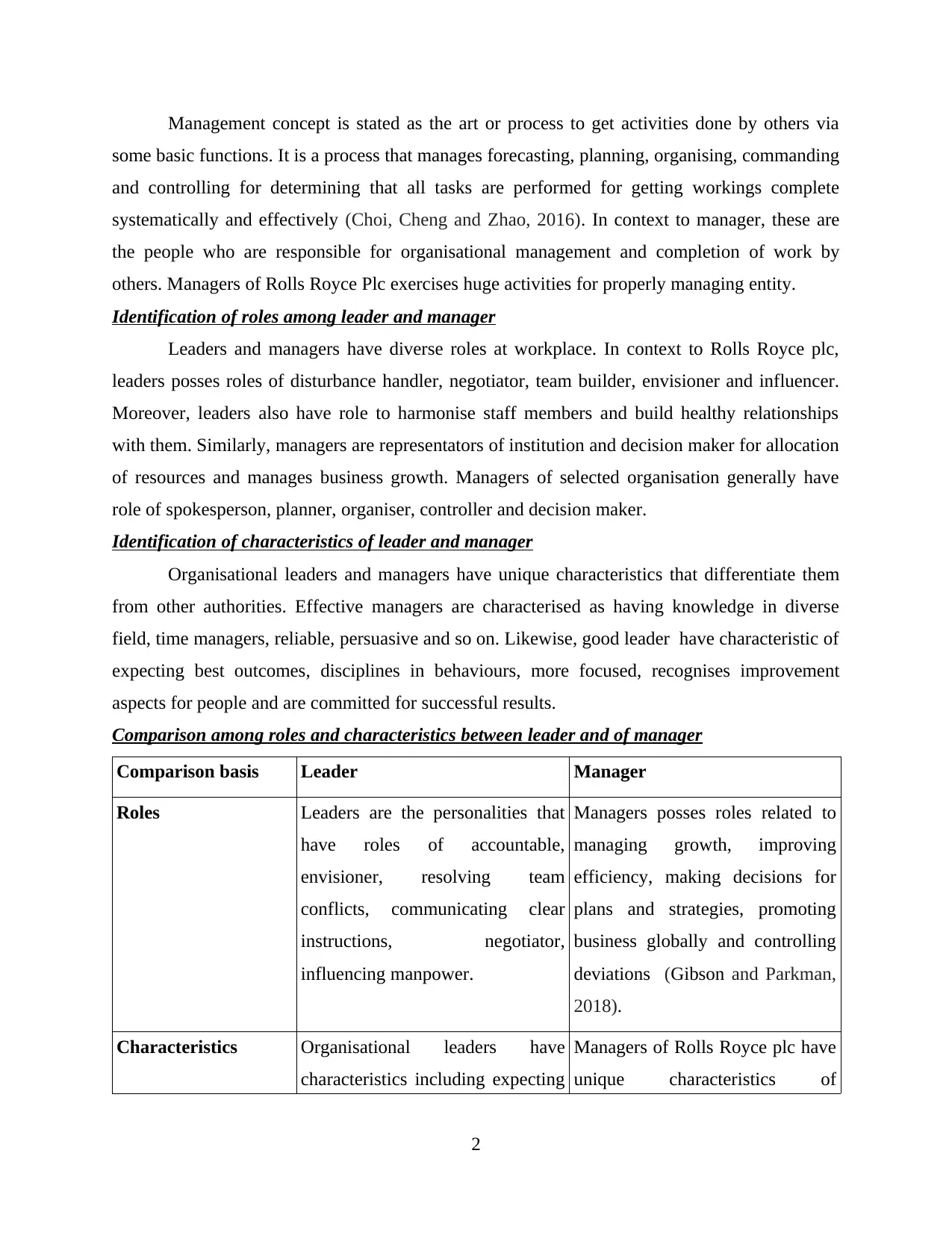
Management concept is stated as the art or process to get activities done by others via
some basic functions. It is a process that manages forecasting, planning, organising, commanding
and controlling for determining that all tasks are performed for getting workings complete
systematically and effectively (Choi, Cheng and Zhao, 2016). In context to manager, these are
the people who are responsible for organisational management and completion of work by
others. Managers of Rolls Royce Plc exercises huge activities for properly managing entity.
Identification of roles among leader and manager
Leaders and managers have diverse roles at workplace. In context to Rolls Royce plc,
leaders posses roles of disturbance handler, negotiator, team builder, envisioner and influencer.
Moreover, leaders also have role to harmonise staff members and build healthy relationships
with them. Similarly, managers are representators of institution and decision maker for allocation
of resources and manages business growth. Managers of selected organisation generally have
role of spokesperson, planner, organiser, controller and decision maker.
Identification of characteristics of leader and manager
Organisational leaders and managers have unique characteristics that differentiate them
from other authorities. Effective managers are characterised as having knowledge in diverse
field, time managers, reliable, persuasive and so on. Likewise, good leader have characteristic of
expecting best outcomes, disciplines in behaviours, more focused, recognises improvement
aspects for people and are committed for successful results.
Comparison among roles and characteristics between leader and of manager
Comparison basis Leader Manager
Roles Leaders are the personalities that
have roles of accountable,
envisioner, resolving team
conflicts, communicating clear
instructions, negotiator,
influencing manpower.
Managers posses roles related to
managing growth, improving
efficiency, making decisions for
plans and strategies, promoting
business globally and controlling
deviations (Gibson and Parkman,
2018).
Characteristics Organisational leaders have
characteristics including expecting
Managers of Rolls Royce plc have
unique characteristics of
2
some basic functions. It is a process that manages forecasting, planning, organising, commanding
and controlling for determining that all tasks are performed for getting workings complete
systematically and effectively (Choi, Cheng and Zhao, 2016). In context to manager, these are
the people who are responsible for organisational management and completion of work by
others. Managers of Rolls Royce Plc exercises huge activities for properly managing entity.
Identification of roles among leader and manager
Leaders and managers have diverse roles at workplace. In context to Rolls Royce plc,
leaders posses roles of disturbance handler, negotiator, team builder, envisioner and influencer.
Moreover, leaders also have role to harmonise staff members and build healthy relationships
with them. Similarly, managers are representators of institution and decision maker for allocation
of resources and manages business growth. Managers of selected organisation generally have
role of spokesperson, planner, organiser, controller and decision maker.
Identification of characteristics of leader and manager
Organisational leaders and managers have unique characteristics that differentiate them
from other authorities. Effective managers are characterised as having knowledge in diverse
field, time managers, reliable, persuasive and so on. Likewise, good leader have characteristic of
expecting best outcomes, disciplines in behaviours, more focused, recognises improvement
aspects for people and are committed for successful results.
Comparison among roles and characteristics between leader and of manager
Comparison basis Leader Manager
Roles Leaders are the personalities that
have roles of accountable,
envisioner, resolving team
conflicts, communicating clear
instructions, negotiator,
influencing manpower.
Managers posses roles related to
managing growth, improving
efficiency, making decisions for
plans and strategies, promoting
business globally and controlling
deviations (Gibson and Parkman,
2018).
Characteristics Organisational leaders have
characteristics including expecting
Managers of Rolls Royce plc have
unique characteristics of
2
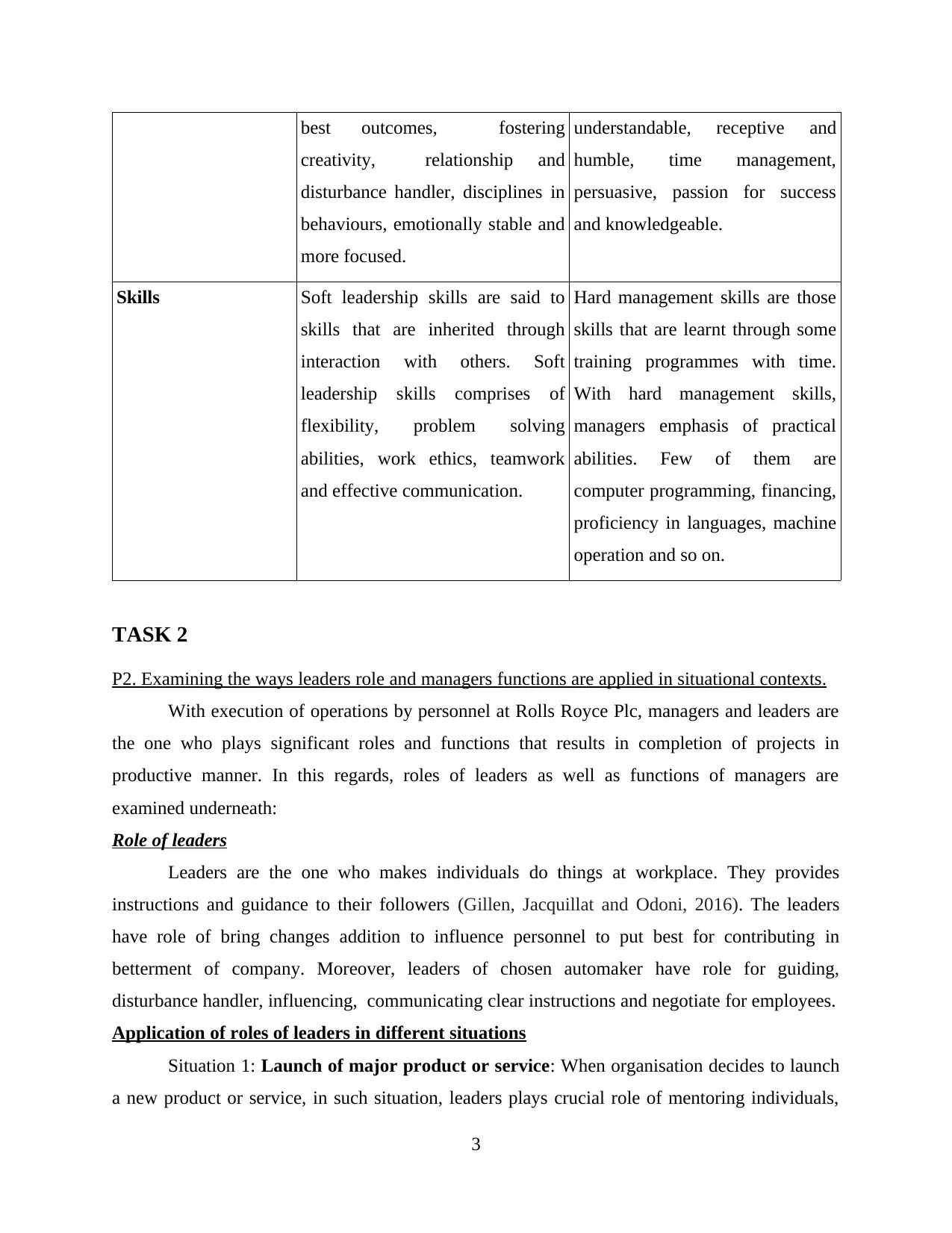
best outcomes, fostering
creativity, relationship and
disturbance handler, disciplines in
behaviours, emotionally stable and
more focused.
understandable, receptive and
humble, time management,
persuasive, passion for success
and knowledgeable.
Skills Soft leadership skills are said to
skills that are inherited through
interaction with others. Soft
leadership skills comprises of
flexibility, problem solving
abilities, work ethics, teamwork
and effective communication.
Hard management skills are those
skills that are learnt through some
training programmes with time.
With hard management skills,
managers emphasis of practical
abilities. Few of them are
computer programming, financing,
proficiency in languages, machine
operation and so on.
TASK 2
P2. Examining the ways leaders role and managers functions are applied in situational contexts.
With execution of operations by personnel at Rolls Royce Plc, managers and leaders are
the one who plays significant roles and functions that results in completion of projects in
productive manner. In this regards, roles of leaders as well as functions of managers are
examined underneath:
Role of leaders
Leaders are the one who makes individuals do things at workplace. They provides
instructions and guidance to their followers (Gillen, Jacquillat and Odoni, 2016). The leaders
have role of bring changes addition to influence personnel to put best for contributing in
betterment of company. Moreover, leaders of chosen automaker have role for guiding,
disturbance handler, influencing, communicating clear instructions and negotiate for employees.
Application of roles of leaders in different situations
Situation 1: Launch of major product or service: When organisation decides to launch
a new product or service, in such situation, leaders plays crucial role of mentoring individuals,
3
creativity, relationship and
disturbance handler, disciplines in
behaviours, emotionally stable and
more focused.
understandable, receptive and
humble, time management,
persuasive, passion for success
and knowledgeable.
Skills Soft leadership skills are said to
skills that are inherited through
interaction with others. Soft
leadership skills comprises of
flexibility, problem solving
abilities, work ethics, teamwork
and effective communication.
Hard management skills are those
skills that are learnt through some
training programmes with time.
With hard management skills,
managers emphasis of practical
abilities. Few of them are
computer programming, financing,
proficiency in languages, machine
operation and so on.
TASK 2
P2. Examining the ways leaders role and managers functions are applied in situational contexts.
With execution of operations by personnel at Rolls Royce Plc, managers and leaders are
the one who plays significant roles and functions that results in completion of projects in
productive manner. In this regards, roles of leaders as well as functions of managers are
examined underneath:
Role of leaders
Leaders are the one who makes individuals do things at workplace. They provides
instructions and guidance to their followers (Gillen, Jacquillat and Odoni, 2016). The leaders
have role of bring changes addition to influence personnel to put best for contributing in
betterment of company. Moreover, leaders of chosen automaker have role for guiding,
disturbance handler, influencing, communicating clear instructions and negotiate for employees.
Application of roles of leaders in different situations
Situation 1: Launch of major product or service: When organisation decides to launch
a new product or service, in such situation, leaders plays crucial role of mentoring individuals,
3
⊘ This is a preview!⊘
Do you want full access?
Subscribe today to unlock all pages.

Trusted by 1+ million students worldwide
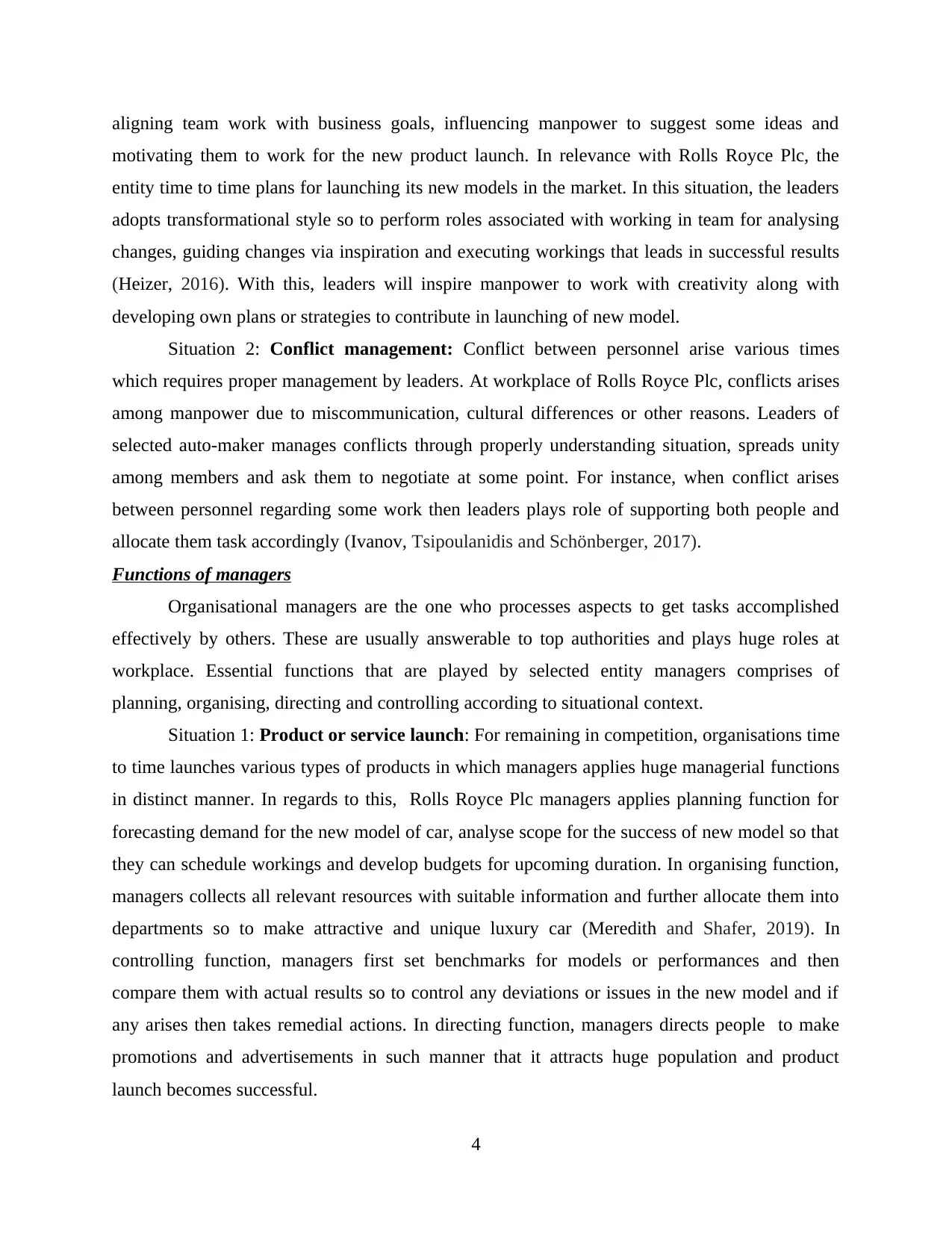
aligning team work with business goals, influencing manpower to suggest some ideas and
motivating them to work for the new product launch. In relevance with Rolls Royce Plc, the
entity time to time plans for launching its new models in the market. In this situation, the leaders
adopts transformational style so to perform roles associated with working in team for analysing
changes, guiding changes via inspiration and executing workings that leads in successful results
(Heizer, 2016). With this, leaders will inspire manpower to work with creativity along with
developing own plans or strategies to contribute in launching of new model.
Situation 2: Conflict management: Conflict between personnel arise various times
which requires proper management by leaders. At workplace of Rolls Royce Plc, conflicts arises
among manpower due to miscommunication, cultural differences or other reasons. Leaders of
selected auto-maker manages conflicts through properly understanding situation, spreads unity
among members and ask them to negotiate at some point. For instance, when conflict arises
between personnel regarding some work then leaders plays role of supporting both people and
allocate them task accordingly (Ivanov, Tsipoulanidis and Schönberger, 2017).
Functions of managers
Organisational managers are the one who processes aspects to get tasks accomplished
effectively by others. These are usually answerable to top authorities and plays huge roles at
workplace. Essential functions that are played by selected entity managers comprises of
planning, organising, directing and controlling according to situational context.
Situation 1: Product or service launch: For remaining in competition, organisations time
to time launches various types of products in which managers applies huge managerial functions
in distinct manner. In regards to this, Rolls Royce Plc managers applies planning function for
forecasting demand for the new model of car, analyse scope for the success of new model so that
they can schedule workings and develop budgets for upcoming duration. In organising function,
managers collects all relevant resources with suitable information and further allocate them into
departments so to make attractive and unique luxury car (Meredith and Shafer, 2019). In
controlling function, managers first set benchmarks for models or performances and then
compare them with actual results so to control any deviations or issues in the new model and if
any arises then takes remedial actions. In directing function, managers directs people to make
promotions and advertisements in such manner that it attracts huge population and product
launch becomes successful.
4
motivating them to work for the new product launch. In relevance with Rolls Royce Plc, the
entity time to time plans for launching its new models in the market. In this situation, the leaders
adopts transformational style so to perform roles associated with working in team for analysing
changes, guiding changes via inspiration and executing workings that leads in successful results
(Heizer, 2016). With this, leaders will inspire manpower to work with creativity along with
developing own plans or strategies to contribute in launching of new model.
Situation 2: Conflict management: Conflict between personnel arise various times
which requires proper management by leaders. At workplace of Rolls Royce Plc, conflicts arises
among manpower due to miscommunication, cultural differences or other reasons. Leaders of
selected auto-maker manages conflicts through properly understanding situation, spreads unity
among members and ask them to negotiate at some point. For instance, when conflict arises
between personnel regarding some work then leaders plays role of supporting both people and
allocate them task accordingly (Ivanov, Tsipoulanidis and Schönberger, 2017).
Functions of managers
Organisational managers are the one who processes aspects to get tasks accomplished
effectively by others. These are usually answerable to top authorities and plays huge roles at
workplace. Essential functions that are played by selected entity managers comprises of
planning, organising, directing and controlling according to situational context.
Situation 1: Product or service launch: For remaining in competition, organisations time
to time launches various types of products in which managers applies huge managerial functions
in distinct manner. In regards to this, Rolls Royce Plc managers applies planning function for
forecasting demand for the new model of car, analyse scope for the success of new model so that
they can schedule workings and develop budgets for upcoming duration. In organising function,
managers collects all relevant resources with suitable information and further allocate them into
departments so to make attractive and unique luxury car (Meredith and Shafer, 2019). In
controlling function, managers first set benchmarks for models or performances and then
compare them with actual results so to control any deviations or issues in the new model and if
any arises then takes remedial actions. In directing function, managers directs people to make
promotions and advertisements in such manner that it attracts huge population and product
launch becomes successful.
4
Paraphrase This Document
Need a fresh take? Get an instant paraphrase of this document with our AI Paraphraser

Situation 2: Managing conflict: Managers of entity through applying suitable functions
effectively manages conflicts at workplace. For example, when tools and equipments are limited
and two persons needs them at same time, then there are chances for conflicts. To manage the
conflict managers performs various activities such as in planning function, managers plans to
initiate activities for pairing up and interacting with employees. In this, they searches suitable
solutions that leads in management of all types of conflicts among personnels. In this, managers
forecast the business environment and employee behaviour so that they can provide healthy work
environment along with required tools and equipments in which people work with harmony that
reduces conflict aspects. Work performed by managers in organising function is related to
gathering required tools as well as equipments and providing them to employees at the time
required (Reid and Sanders, 2019). Managers also direct people about the ways they can manage
workings for requirements of tools at same time that results in managing conflict related
situations effectively.
P3. Application of theories and models of approaches.
Leadership theories which are applied by leaders of Rolls Royce in distinct situation are
underneath:
Situational leadership theory: It is defined as timeless along with repeatable theory for
leaders in order to match their styles or behaviours with individual performance needs which
they are attempting for stimulation. As per Hersey and Blanchard, becoming leader is nor easy as
well as there are different ways in which leadership is executed in different situation. Factors that
are part of the situational model are delegating style, selling style, participative style and telling
style. At Rolls Royce Plc, leaders opts suitable factor or style as per the context of situation.
Such as, in conflict management situation, situational theory is implemented in which leaders
diagnose entire situation through so to analyse reasons for the conflicts and accordingly adapt
styles in order to respond to situational contingency and manage conflicts (Slack and Brandon-
Jones, 2018). Moreover, thorough participative style, leaders work with employees and analyse
reasons of conflict which further help in planning suitable aspect that leads in properly managing
conflicts. In context to next situation that is launching product, leaders also applies the situational
theory in which they initiates activities with following delegating style as per the scenario so that
responsibilities to different personnels are delegated for properly achieving success for launching
of model. With this theory, personnel at different designation creates shared endeavour as well as
5
effectively manages conflicts at workplace. For example, when tools and equipments are limited
and two persons needs them at same time, then there are chances for conflicts. To manage the
conflict managers performs various activities such as in planning function, managers plans to
initiate activities for pairing up and interacting with employees. In this, they searches suitable
solutions that leads in management of all types of conflicts among personnels. In this, managers
forecast the business environment and employee behaviour so that they can provide healthy work
environment along with required tools and equipments in which people work with harmony that
reduces conflict aspects. Work performed by managers in organising function is related to
gathering required tools as well as equipments and providing them to employees at the time
required (Reid and Sanders, 2019). Managers also direct people about the ways they can manage
workings for requirements of tools at same time that results in managing conflict related
situations effectively.
P3. Application of theories and models of approaches.
Leadership theories which are applied by leaders of Rolls Royce in distinct situation are
underneath:
Situational leadership theory: It is defined as timeless along with repeatable theory for
leaders in order to match their styles or behaviours with individual performance needs which
they are attempting for stimulation. As per Hersey and Blanchard, becoming leader is nor easy as
well as there are different ways in which leadership is executed in different situation. Factors that
are part of the situational model are delegating style, selling style, participative style and telling
style. At Rolls Royce Plc, leaders opts suitable factor or style as per the context of situation.
Such as, in conflict management situation, situational theory is implemented in which leaders
diagnose entire situation through so to analyse reasons for the conflicts and accordingly adapt
styles in order to respond to situational contingency and manage conflicts (Slack and Brandon-
Jones, 2018). Moreover, thorough participative style, leaders work with employees and analyse
reasons of conflict which further help in planning suitable aspect that leads in properly managing
conflicts. In context to next situation that is launching product, leaders also applies the situational
theory in which they initiates activities with following delegating style as per the scenario so that
responsibilities to different personnels are delegated for properly achieving success for launching
of model. With this theory, personnel at different designation creates shared endeavour as well as
5
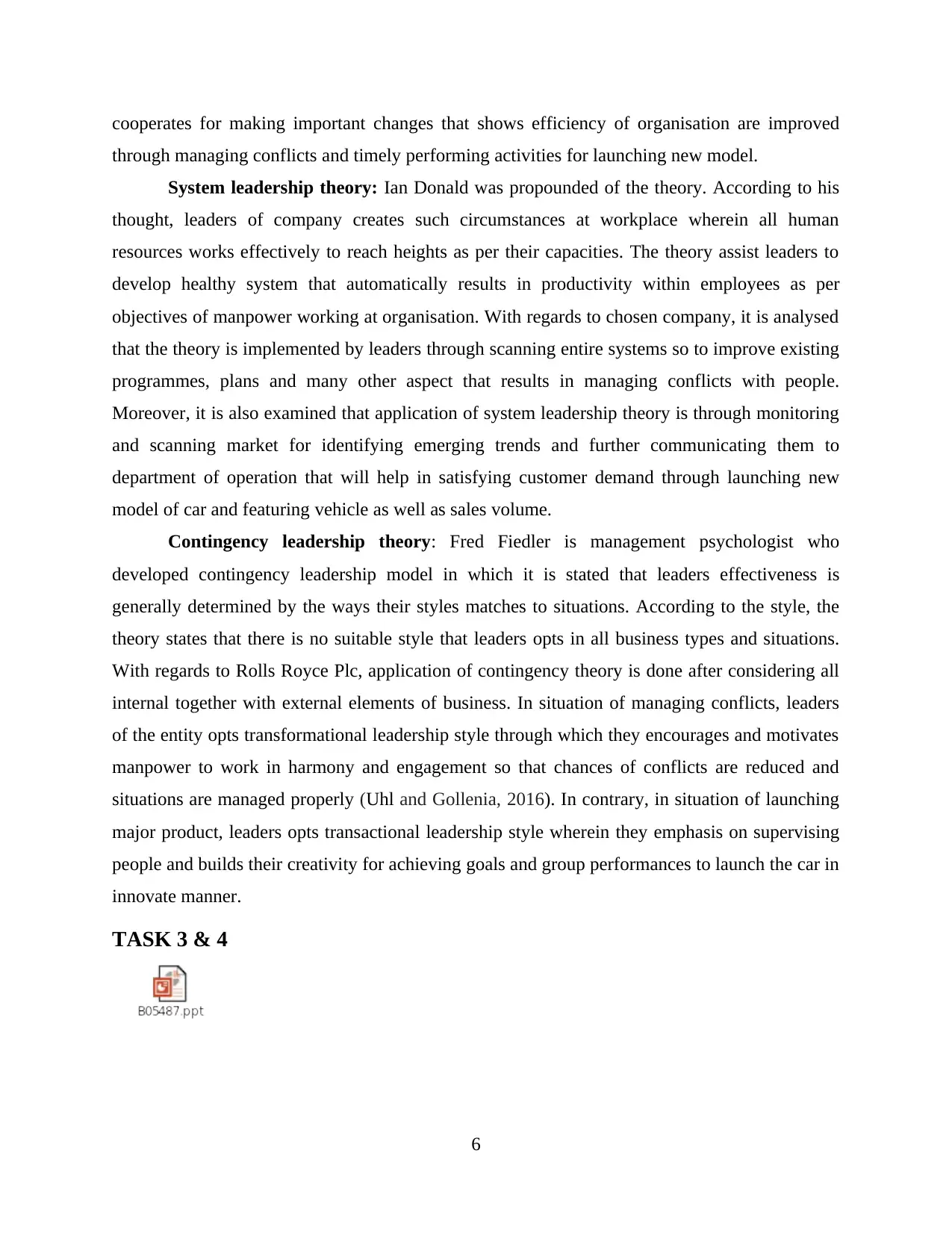
cooperates for making important changes that shows efficiency of organisation are improved
through managing conflicts and timely performing activities for launching new model.
System leadership theory: Ian Donald was propounded of the theory. According to his
thought, leaders of company creates such circumstances at workplace wherein all human
resources works effectively to reach heights as per their capacities. The theory assist leaders to
develop healthy system that automatically results in productivity within employees as per
objectives of manpower working at organisation. With regards to chosen company, it is analysed
that the theory is implemented by leaders through scanning entire systems so to improve existing
programmes, plans and many other aspect that results in managing conflicts with people.
Moreover, it is also examined that application of system leadership theory is through monitoring
and scanning market for identifying emerging trends and further communicating them to
department of operation that will help in satisfying customer demand through launching new
model of car and featuring vehicle as well as sales volume.
Contingency leadership theory: Fred Fiedler is management psychologist who
developed contingency leadership model in which it is stated that leaders effectiveness is
generally determined by the ways their styles matches to situations. According to the style, the
theory states that there is no suitable style that leaders opts in all business types and situations.
With regards to Rolls Royce Plc, application of contingency theory is done after considering all
internal together with external elements of business. In situation of managing conflicts, leaders
of the entity opts transformational leadership style through which they encourages and motivates
manpower to work in harmony and engagement so that chances of conflicts are reduced and
situations are managed properly (Uhl and Gollenia, 2016). In contrary, in situation of launching
major product, leaders opts transactional leadership style wherein they emphasis on supervising
people and builds their creativity for achieving goals and group performances to launch the car in
innovate manner.
TASK 3 & 4
6
through managing conflicts and timely performing activities for launching new model.
System leadership theory: Ian Donald was propounded of the theory. According to his
thought, leaders of company creates such circumstances at workplace wherein all human
resources works effectively to reach heights as per their capacities. The theory assist leaders to
develop healthy system that automatically results in productivity within employees as per
objectives of manpower working at organisation. With regards to chosen company, it is analysed
that the theory is implemented by leaders through scanning entire systems so to improve existing
programmes, plans and many other aspect that results in managing conflicts with people.
Moreover, it is also examined that application of system leadership theory is through monitoring
and scanning market for identifying emerging trends and further communicating them to
department of operation that will help in satisfying customer demand through launching new
model of car and featuring vehicle as well as sales volume.
Contingency leadership theory: Fred Fiedler is management psychologist who
developed contingency leadership model in which it is stated that leaders effectiveness is
generally determined by the ways their styles matches to situations. According to the style, the
theory states that there is no suitable style that leaders opts in all business types and situations.
With regards to Rolls Royce Plc, application of contingency theory is done after considering all
internal together with external elements of business. In situation of managing conflicts, leaders
of the entity opts transformational leadership style through which they encourages and motivates
manpower to work in harmony and engagement so that chances of conflicts are reduced and
situations are managed properly (Uhl and Gollenia, 2016). In contrary, in situation of launching
major product, leaders opts transactional leadership style wherein they emphasis on supervising
people and builds their creativity for achieving goals and group performances to launch the car in
innovate manner.
TASK 3 & 4
6
⊘ This is a preview!⊘
Do you want full access?
Subscribe today to unlock all pages.

Trusted by 1+ million students worldwide
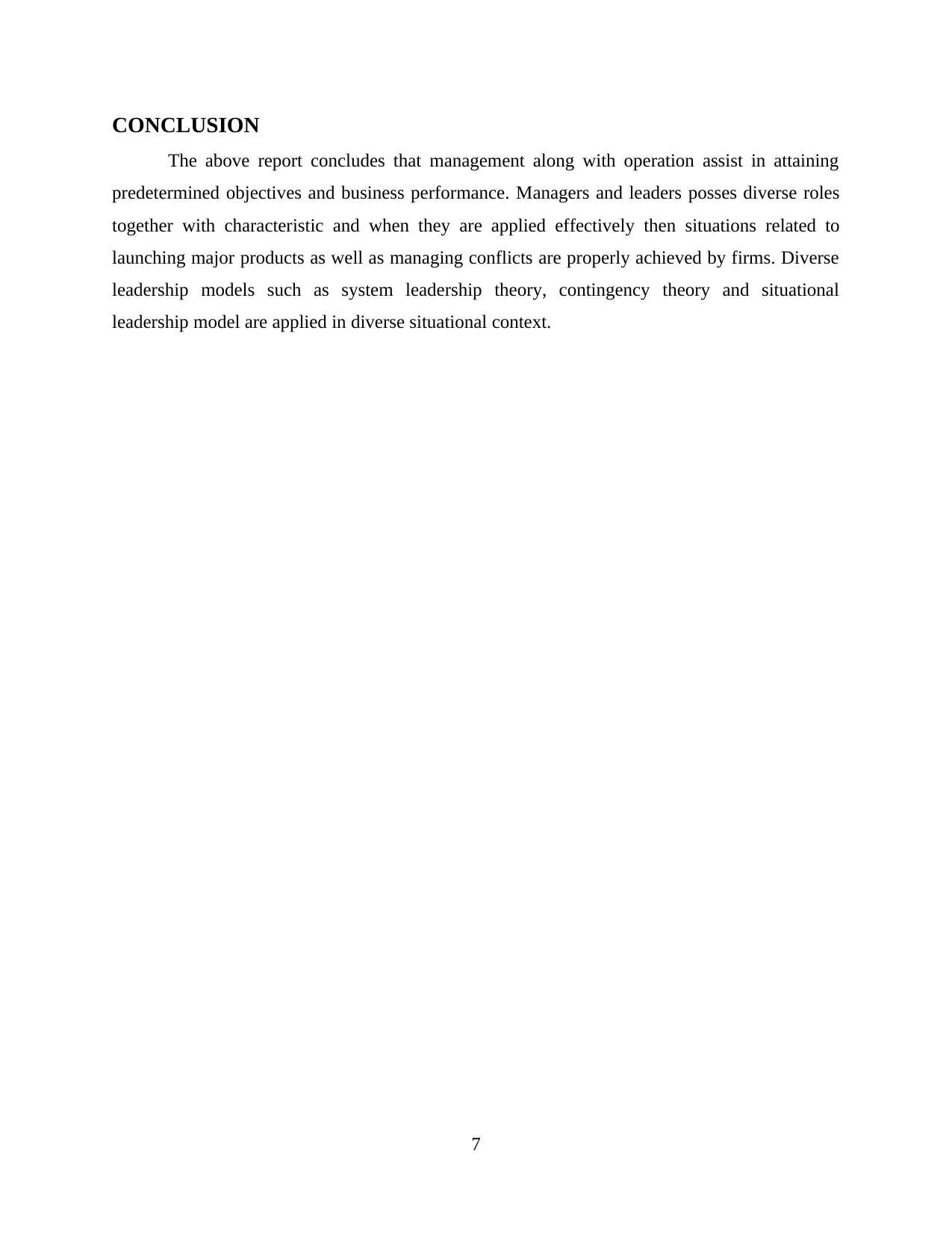
CONCLUSION
The above report concludes that management along with operation assist in attaining
predetermined objectives and business performance. Managers and leaders posses diverse roles
together with characteristic and when they are applied effectively then situations related to
launching major products as well as managing conflicts are properly achieved by firms. Diverse
leadership models such as system leadership theory, contingency theory and situational
leadership model are applied in diverse situational context.
7
The above report concludes that management along with operation assist in attaining
predetermined objectives and business performance. Managers and leaders posses diverse roles
together with characteristic and when they are applied effectively then situations related to
launching major products as well as managing conflicts are properly achieved by firms. Diverse
leadership models such as system leadership theory, contingency theory and situational
leadership model are applied in diverse situational context.
7
Paraphrase This Document
Need a fresh take? Get an instant paraphrase of this document with our AI Paraphraser
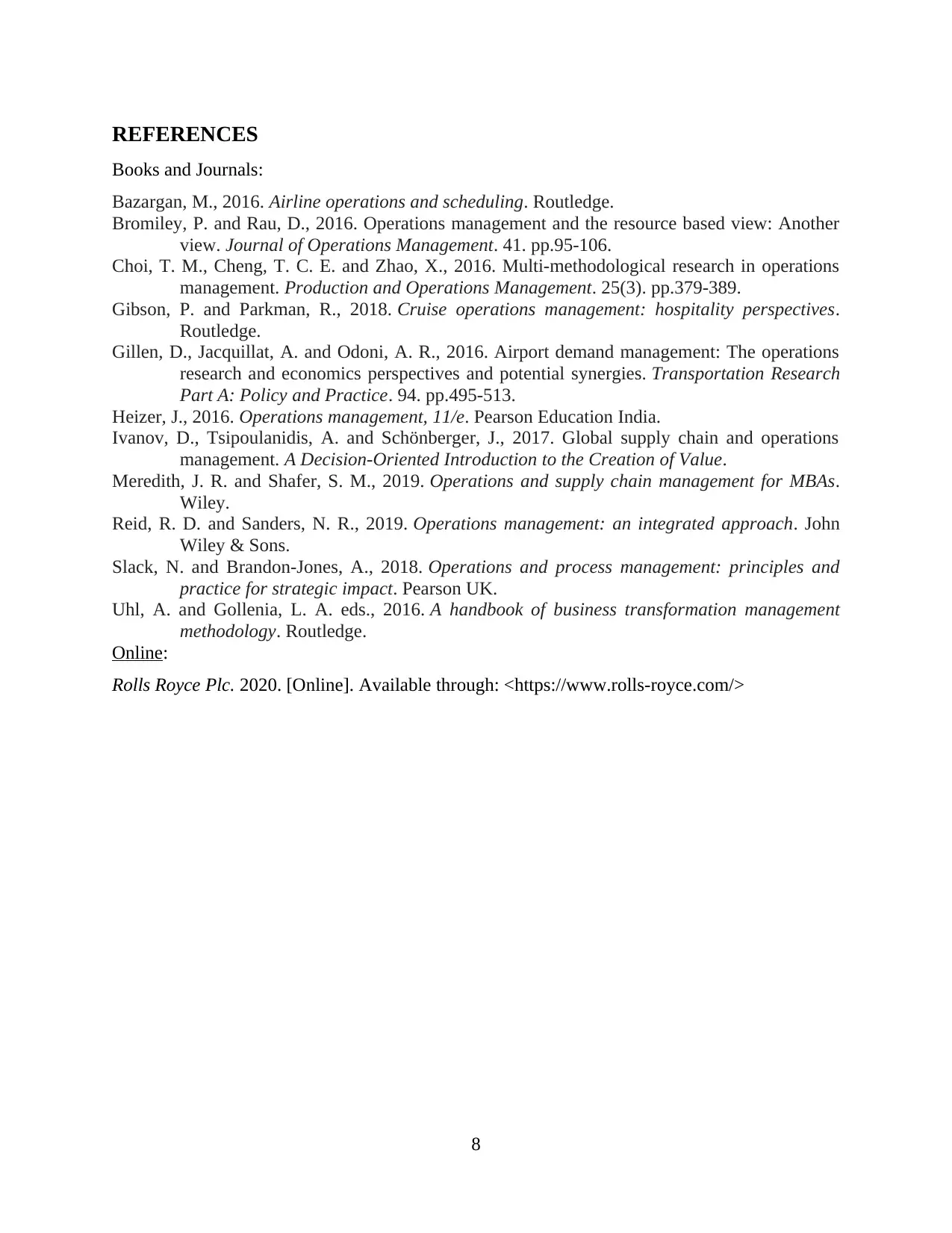
REFERENCES
Books and Journals:
Bazargan, M., 2016. Airline operations and scheduling. Routledge.
Bromiley, P. and Rau, D., 2016. Operations management and the resource based view: Another
view. Journal of Operations Management. 41. pp.95-106.
Choi, T. M., Cheng, T. C. E. and Zhao, X., 2016. Multi‐methodological research in operations
management. Production and Operations Management. 25(3). pp.379-389.
Gibson, P. and Parkman, R., 2018. Cruise operations management: hospitality perspectives.
Routledge.
Gillen, D., Jacquillat, A. and Odoni, A. R., 2016. Airport demand management: The operations
research and economics perspectives and potential synergies. Transportation Research
Part A: Policy and Practice. 94. pp.495-513.
Heizer, J., 2016. Operations management, 11/e. Pearson Education India.
Ivanov, D., Tsipoulanidis, A. and Schönberger, J., 2017. Global supply chain and operations
management. A Decision-Oriented Introduction to the Creation of Value.
Meredith, J. R. and Shafer, S. M., 2019. Operations and supply chain management for MBAs.
Wiley.
Reid, R. D. and Sanders, N. R., 2019. Operations management: an integrated approach. John
Wiley & Sons.
Slack, N. and Brandon-Jones, A., 2018. Operations and process management: principles and
practice for strategic impact. Pearson UK.
Uhl, A. and Gollenia, L. A. eds., 2016. A handbook of business transformation management
methodology. Routledge.
Online:
Rolls Royce Plc. 2020. [Online]. Available through: <https://www.rolls-royce.com/>
8
Books and Journals:
Bazargan, M., 2016. Airline operations and scheduling. Routledge.
Bromiley, P. and Rau, D., 2016. Operations management and the resource based view: Another
view. Journal of Operations Management. 41. pp.95-106.
Choi, T. M., Cheng, T. C. E. and Zhao, X., 2016. Multi‐methodological research in operations
management. Production and Operations Management. 25(3). pp.379-389.
Gibson, P. and Parkman, R., 2018. Cruise operations management: hospitality perspectives.
Routledge.
Gillen, D., Jacquillat, A. and Odoni, A. R., 2016. Airport demand management: The operations
research and economics perspectives and potential synergies. Transportation Research
Part A: Policy and Practice. 94. pp.495-513.
Heizer, J., 2016. Operations management, 11/e. Pearson Education India.
Ivanov, D., Tsipoulanidis, A. and Schönberger, J., 2017. Global supply chain and operations
management. A Decision-Oriented Introduction to the Creation of Value.
Meredith, J. R. and Shafer, S. M., 2019. Operations and supply chain management for MBAs.
Wiley.
Reid, R. D. and Sanders, N. R., 2019. Operations management: an integrated approach. John
Wiley & Sons.
Slack, N. and Brandon-Jones, A., 2018. Operations and process management: principles and
practice for strategic impact. Pearson UK.
Uhl, A. and Gollenia, L. A. eds., 2016. A handbook of business transformation management
methodology. Routledge.
Online:
Rolls Royce Plc. 2020. [Online]. Available through: <https://www.rolls-royce.com/>
8
1 out of 11
Related Documents
Your All-in-One AI-Powered Toolkit for Academic Success.
+13062052269
info@desklib.com
Available 24*7 on WhatsApp / Email
![[object Object]](/_next/static/media/star-bottom.7253800d.svg)
Unlock your academic potential
Copyright © 2020–2025 A2Z Services. All Rights Reserved. Developed and managed by ZUCOL.





